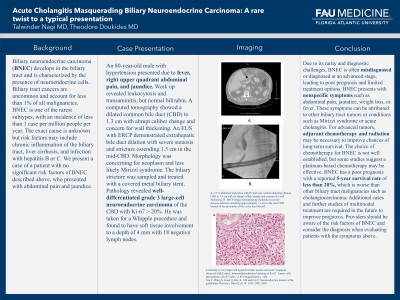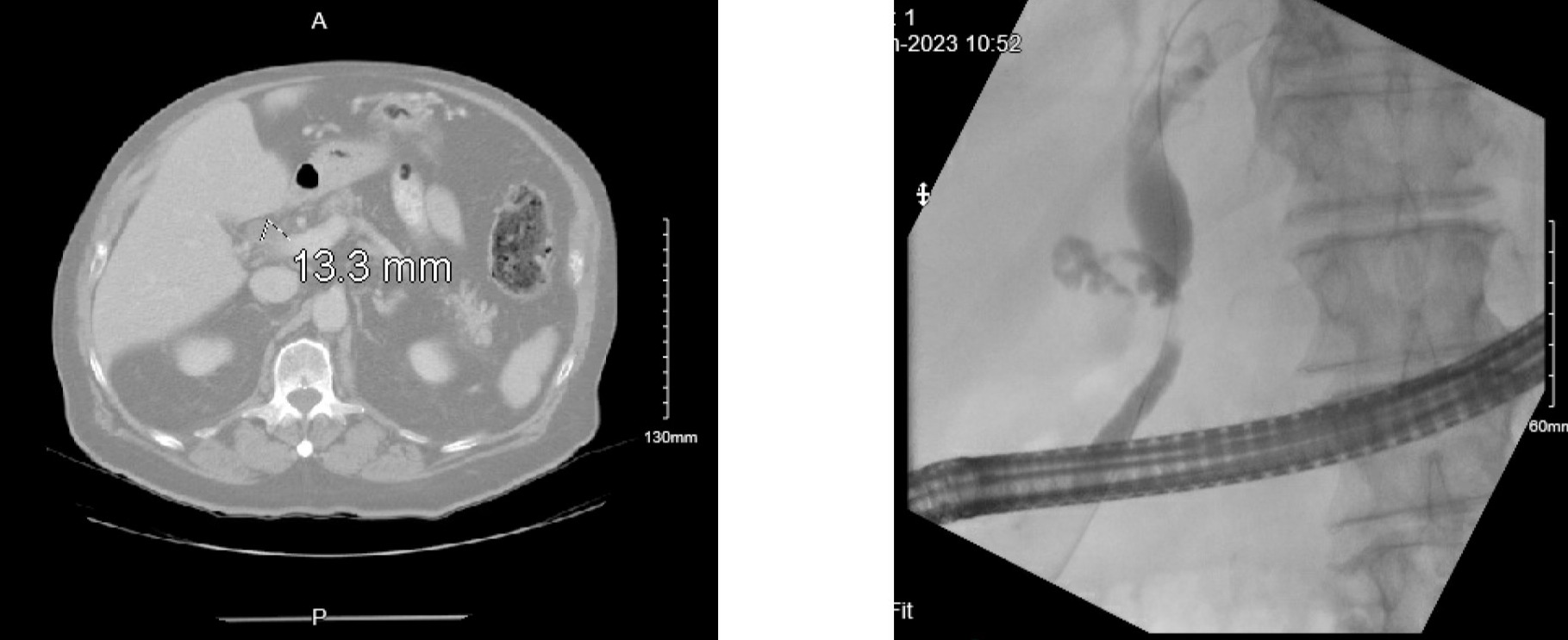Tuesday Poster Session
Category: Biliary/Pancreas
P2964 - Acute Cholangitis Masquerading Biliary Neuroendocrine Carcinoma: A Rare Twist to a Typical Presentation
Tuesday, October 24, 2023
10:30 AM - 4:00 PM PT
Location: Exhibit Hall

Has Audio

Talwinder Nagi, MD
Florida Atlantic University Charles E. Schmidt College of Medicine
Boca Raton, FL
Presenting Author(s)
Talwinder Nagi, MD1, Theodore Doukides, MD2
1Florida Atlantic University Charles E. Schmidt College of Medicine, Boca Raton, FL; 2Baptist Health South Florida, Boca Raton, FL
Introduction: Biliary neuroendocrine carcinoma (BNEC) develops in the biliary tract and is characterized by the presence of neuroendocrine cells. Biliary tract cancers are uncommon and account for less than 1% of all malignancies. BNEC is one of the rarest subtypes, with an incidence of less than 1 case per million people per year. The exact cause is unknown but risk factors may include chronic inflammation of the biliary tract, liver cirrhosis, and infection with hepatitis B or C. We present a case of a patient with no significant risk factors of BNEC described above, who presented with abdominal pain and jaundice.
Case Description/Methods: An 80-year-old male with hypertension presented due to fever, right upper quadrant abdominal pain, and jaundice. Work up revealed leukocytosis and transaminitis, but normal bilirubin. A computed tomography showed a dilated common bile duct (CBD) to 1.3 cm with abrupt caliber change and concern for wall thickening. An EUS with ERCP demonstrated extrahepatic bile duct dilation with severe stenosis and stricture extending 1.5 cm in the mid-CBD. Morphology was concerning for neoplasm and less likely Mirizzi syndrome. The biliary stricture was sampled and treated with a covered metal biliary stent. Pathology revealed well-differentiated grade 3 large-cell neuroendocrine carcinoma of the CBD with Ki-67 > 20%. He was taken for a Whipple procedure and found to have soft tissue involvement to a depth of 4 mm with 18 negative lymph nodes.
Discussion: Due to its rarity and diagnostic challenges, BNEC is often misdiagnosed or diagnosed at an advanced stage, leading to poor prognosis and limited treatment options. BNEC presents with nonspecific symptoms such as abdominal pain, jaundice, weight loss, or fever. These symptoms can be attributed to other biliary tract tumors or conditions such as Mirizzi syndrome or acute cholangitis. For advanced tumors, adjuvant chemotherapy and radiation may be necessary to improve chances of long-term survival. The choice of chemotherapy for BNEC is not well established, but some studies suggest a platinum-based chemotherapy may be effective. BNEC has a poor prognosis with a reported 5-year survival rate of less than 20%, which is worse than other biliary tract malignancies such as cholangiocarcinoma. Additional cases and further studies of multimodal treatment are required in the future to improve prognosis. Providers should be aware of the risk factors of BNEC and consider the diagnosis when evaluating patients with the symptoms above.

Disclosures:
Talwinder Nagi, MD1, Theodore Doukides, MD2. P2964 - Acute Cholangitis Masquerading Biliary Neuroendocrine Carcinoma: A Rare Twist to a Typical Presentation, ACG 2023 Annual Scientific Meeting Abstracts. Vancouver, BC, Canada: American College of Gastroenterology.
1Florida Atlantic University Charles E. Schmidt College of Medicine, Boca Raton, FL; 2Baptist Health South Florida, Boca Raton, FL
Introduction: Biliary neuroendocrine carcinoma (BNEC) develops in the biliary tract and is characterized by the presence of neuroendocrine cells. Biliary tract cancers are uncommon and account for less than 1% of all malignancies. BNEC is one of the rarest subtypes, with an incidence of less than 1 case per million people per year. The exact cause is unknown but risk factors may include chronic inflammation of the biliary tract, liver cirrhosis, and infection with hepatitis B or C. We present a case of a patient with no significant risk factors of BNEC described above, who presented with abdominal pain and jaundice.
Case Description/Methods: An 80-year-old male with hypertension presented due to fever, right upper quadrant abdominal pain, and jaundice. Work up revealed leukocytosis and transaminitis, but normal bilirubin. A computed tomography showed a dilated common bile duct (CBD) to 1.3 cm with abrupt caliber change and concern for wall thickening. An EUS with ERCP demonstrated extrahepatic bile duct dilation with severe stenosis and stricture extending 1.5 cm in the mid-CBD. Morphology was concerning for neoplasm and less likely Mirizzi syndrome. The biliary stricture was sampled and treated with a covered metal biliary stent. Pathology revealed well-differentiated grade 3 large-cell neuroendocrine carcinoma of the CBD with Ki-67 > 20%. He was taken for a Whipple procedure and found to have soft tissue involvement to a depth of 4 mm with 18 negative lymph nodes.
Discussion: Due to its rarity and diagnostic challenges, BNEC is often misdiagnosed or diagnosed at an advanced stage, leading to poor prognosis and limited treatment options. BNEC presents with nonspecific symptoms such as abdominal pain, jaundice, weight loss, or fever. These symptoms can be attributed to other biliary tract tumors or conditions such as Mirizzi syndrome or acute cholangitis. For advanced tumors, adjuvant chemotherapy and radiation may be necessary to improve chances of long-term survival. The choice of chemotherapy for BNEC is not well established, but some studies suggest a platinum-based chemotherapy may be effective. BNEC has a poor prognosis with a reported 5-year survival rate of less than 20%, which is worse than other biliary tract malignancies such as cholangiocarcinoma. Additional cases and further studies of multimodal treatment are required in the future to improve prognosis. Providers should be aware of the risk factors of BNEC and consider the diagnosis when evaluating patients with the symptoms above.

Figure: A. CT of abdomen and pelvis with IV and oral contrast depicting dilated CBD to 1.3 cm with an abrupt caliber change and concern for wall thickening.
B. ERCP image demonstrating moderate-to-severe stenosis/stricture extending approximately 1.5 cm in the mid CBD located in the proximity of the cystic duct takeoff.
B. ERCP image demonstrating moderate-to-severe stenosis/stricture extending approximately 1.5 cm in the mid CBD located in the proximity of the cystic duct takeoff.
Disclosures:
Talwinder Nagi indicated no relevant financial relationships.
Theodore Doukides indicated no relevant financial relationships.
Talwinder Nagi, MD1, Theodore Doukides, MD2. P2964 - Acute Cholangitis Masquerading Biliary Neuroendocrine Carcinoma: A Rare Twist to a Typical Presentation, ACG 2023 Annual Scientific Meeting Abstracts. Vancouver, BC, Canada: American College of Gastroenterology.
